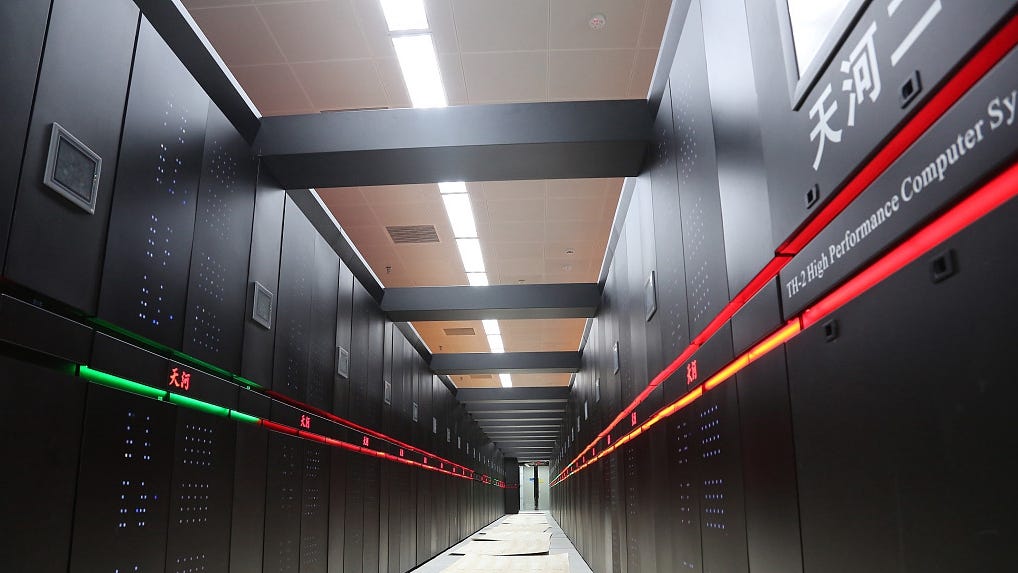A Supercomputer in China has Achieved a Global First with ‘brain-scale’ AI model
A supercomputer in China ran a ‘brain-scale’ AI model with 174 trillion parameters
Hey Guys,
China made a rather incredible announcement last week. Scientists in China say they have been able to run an artificial intelligence model as sophisticated as a human brain on their most powerful supercomputer, a report from the South China Morning Post reveals.
The AI model, dubbed “BaGuaLu” or “alchemist’s pot,” was run on the latest generation of the Sunway supercomputer at the National Supercomputing Center.
The report, citing Chinese scientists, said that the AI model with 174 trillion parameters could be used for several applications ranging from autonomous vehicles to scientific study.
Research team said that its latest Sunway machine is on a par with the US Frontier, named as the world’s most powerful just weeks earlier. China is expected to be on par or slightly ahead of the U.S. in the supercomputer AI arms race.
The data was presented in April during a virtual meeting of Principles and Practice of Parallel Programming 2022, an international conference held by the Association for Computing Machinery (ACM) in the United States.
Sunway supercomputer ran 174 trillion parameters, ‘rivalling the number of synapses in the brain’
As a point of reference, Frontier is the first machine to have demonstrated it can perform more than one quintillion calculations per second.
Interesting Engineering adds: In truth, though the exact number of synapses in a brain is incredibly difficult to map, some estimates suggest the human brain contains up to 1,000 trillion synapses. That's not to say 174 trillion parameters isn't an incredibly impressive number when it comes to the field of artificial intelligence — last year, Google Brain was celebrated for developing an artificial intelligence language model with 1.6 trillion parameters.
A 'brain-scale' supercomputer
The Sunway supercomputer has a speed of a billion operations per second, or 5.3 floating-point operations per second (exaflops). According to the researchers, it has 37 million CPU cores — four times as many as Frontier — and nine petabytes of memory. They also claim the 96,000 semi-independent computer systems, called nodes, resemble the power of a human brain. Communications between these nodes take place at a speed of more than 23 petabytes per second.
The researchers, who refer to their model as a "brain-scale" AI model, say the new Sunway uses proprietary chips with unique features, including energy-saving and broad communication bandwidth.
The team behind the "brain-scale" AI model says their work could be used for autonomous vehicles, computer vision, facial recognition, and chemistry, among a number of other applications. Another Chinese supercomputer, called Tianhe, from the National Supercomputing Centre of Tianjin, was used to rapidly screen and discover pharmaceuticals during the early peak of the Covid-19 pandemic, giving a glimpse at the real-world use cases for these incredibly powerful machines.
It’s of course impossible to verify the story by the SCMP and other Chinese news outlets. The report added that the Sunway supercomputer has more than 37 million CPU cores, four times as many as the US-based Frontier supercomputer. Additionally, the system has nine petabytes of memory, equal to more than 2 million HD movies.
China comparing it to brain-scale A.I. does not make sense entirely, but is a headline that caught my attention in artificial intelligence news.
The latest Sunway “has a speed of a billion billion operations per second”, or 5.3 exaflops and over 37 million CPU cores (four times as many as Frontier), with nine petabytes of memory.
5.3 exaflops is quite impressive.
Using artificial intelligence (AI) and one of the world's fastest supercomputers, Chinese scientists are engineering otherwise unknown chemicals that can be clinically used in the future as well as major advances in drug discovery.
Scientists from Sun Yat-sen University and Beijing-based AI startup Galixir, along with those from the Georgia Institute of Technology and the Massachusetts Institute of Technology, reported a practical deep-learning toolkit to predict the biosynthetic pathways for natural products (NPs) or NP-like compounds in Tianhe-2.
Natural products are the primary source of clinical drug discovery. More than 60 percent of FDA-approved small molecule drugs in the United States are NPs or their derivatives.
Over 300,000 NPs have been recorded to date, but owing to the complex production know-how, only one-tenth have been developed as a substrate or product, with the computer-aided screening urgently needed.
The system used is the Sunway OceanLight (sometimes called OceanLite) is based on 96,000 nodes powered by Sunway's hybrid SW39010 390-core processors featuring almost 40 million cores in total (with CPUs evolved from the SW26010 processors).
According to TechinAsia, the Chinese supercomputer also has 96,000 nodes, which are semi-independent computer systems. These nodes communicate with each other like the human brain’s synapses, which process thoughts and bodily functions.
The drug discovery speed up is considerable though. Inputting any relevant NP molecules into the online toolkit, one can obtain multiple predicted ways to synthesize them in a few minutes. The quick-to-get result is only made possible by Tianhe-2’s strong parallel computing capability and its customized GPU resources, which help shorten the training and testing time from more than two weeks to one day. That’s an order of magnitude that becomes considerable over time.
Comparing a Supercomputer to the human brain is a bit of a spectacle though. We know China is serious in its pursuit of an AI surveillance capitalism where even comments on social media will be vetted. Maybe that is a worthwhile task for such an A.I.
On Friday June 24th, 2022, China's internet watchdog published a new set of draft rules on its website, instructing content platforms to review all online comments before they are published and to report any "illegal and bad information" found to the authorities. According to the South China Morning Post, draft regulations in China "are usually passed without major revisions."
How China will leverage the processing power of its growing ChinaTech dynasty remains to be seen. It seems simultaneously interested in regulating the space while promoting it to go global into more countries. China’s E-commerce and EV companies seem poised to grow globally over the next few years. Daraz, an ecommerce company that Alibaba acquired in 2018, has proved a promising avenue into countries above and around India, for example. With hardly anyone noticing, through Daraz, Alibaba has expanded its reach as the Pakistan-based group spread to Bangladesh, Sri Lanka, Nepal and Myanmar, becoming the region’s largest ecommerce company outside India.
China has 173 supercomputers listed in the Top 500 fastest computer systems in the world, surpassing other countries. But it has not submitted performance data in the last few years. The U.S. may attempt to sanction China due to its ties to Russia in 2023 and to stunt its rapid economic and technological expansion which is growing faster than its own.
China is the Real Alchemist’s Pot
The Chinese team of researchers from the National Research Center of Parallel Computer Engineering and Technology (NRCPC) call their AI model bagualu — alchemist's pot — since it includes about 174 trillion parameters, which rivals the number of synapses in the human brain.
However China’s economic and technological advantage going into the the 2020s is a global advantage of the fourth industrial revolution. For all of its internal issues and geopolitical awkwardness, China is a relentless driver of innovation where the CCP does not even let ChinaTech monopolies have too much power without its consent, approval and guidance under the hood.
If not Huawei, then ByteDance, if not ByteDance china has dozens of impactful companies to challenge Silicon Valley, in fact its growing a host of startups to become a technology dynasty, a pantheon of A.I. driven companies that might one day eclipse those of the United States.
Thanks for reading!







